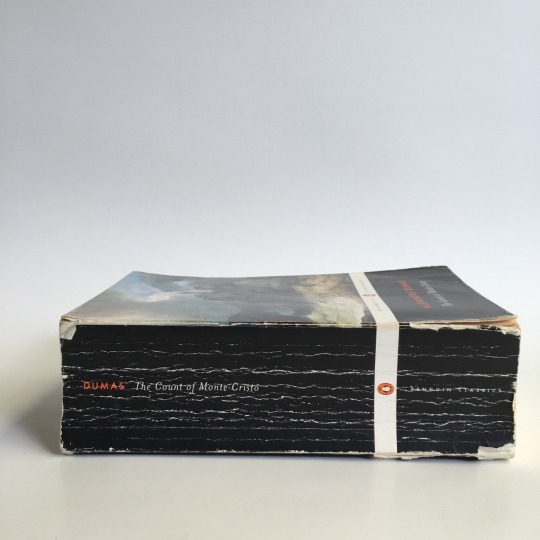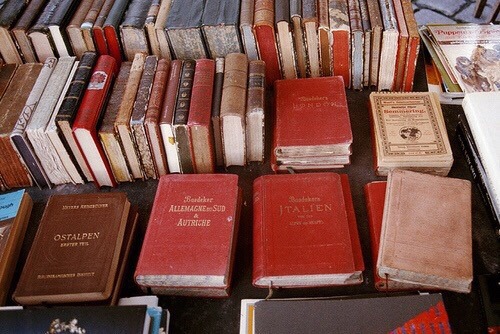The real question is, how many memes am I allowed to post per week? All blog posts are tagged '3178'
Don't wanna be here? Send us removal request.
Text
Curiouser and Curiouser
As my absolute 100% final post, I thought it might be smart to talk a bit more about my project and show a few examples of my code and how the whole idea ties together.
But take ‘absolute 100% final post’ with a pinch of salt because I’ll probably find something else to write about over the weekend.
Coding was not quite as difficult as I thought it was going to be. In fact, I think I enjoyed building this project more than several modules I’ve taken in the past three years.
Twine as a fantastic tool for creating text-based narratives and stories, and I will admit I’ve spent too many hours over the last few weeks playing through different narratives and text based adventure stories (except I keep getting locked in dungeons and collecting too many keys and getting lost in creepy forests).
My intention for this project was to present the poetry of Alice in Wonderland as a kind of wonderland itself - with the visual element of movement throughout the web page, rather than the linear movement of the text. One can move from one location to another, then back to the previous location, or to a new area altogether. What I wanted to do with this text-based story, was keep is as circular as possible, in order to create the effect that the player is actually in wonderland themselves; walking down twists and turns through the forest, and the repetitive nature of the characters and their poetry also reflects the madness the book is so well known for.

The code for individual pages was definitely interesting. Some I was able to write in half an hour, others took much, much, much longer. For example, in the original print of Alice in Wonderland, ‘The Mouses Tale’ is designed to wind down the page in the shape of a tail, becoming smaller and smaller as it goes on. Well let me tell you, that was not fun to try and reproduce in an HTML page.

This is only a portion of the HTML for this particular poem. Essentially, the position, style, and size of each line had to be altered to precise specifications in order for the poem to look the way it does. It took a lot of time, and a lot of testing to try and figure it out, but it’s probably the one piece of this project I’m proudest of.

The rest was a lot more enjoyable and a lot less tiring, however, there’s still things to I’d like to add (it’s not deadline day yet thank goodness) in terms of improving the overall aesthetic of the project, and mostly to explore different coding styles a little more. I think the problem here though, is that this is the kind of project where it’s very easy to get sucked into, in terms of adding content and playing around with different strings of code and style. There is SO much I want to add to this whole project, however I know I’m the kind of person who would spend all their energy on it, and neglect everything else; also I’d fear it would get too out of hand and crazy and I would literally descent into the madness of Wonderland.
As mentioned, I tried to keep this project as self-contained and circular as popular. Which is why, when you try to leave through the designated exits (escape lights on the floor will guide you and remember, these exits may be behind you) you’re taken to different Alice in Wonderland related links and videos. I wanted to create the sense that, almost like the Hotel California, you can never leave; you’re forced to wander around Wonderland over and over until you become as mad as the Hatter!
But this definitely brings me back to the previous blog, linking Wonderland to a sort of internet style phenomenon. It’s so easy to get lost and discover new things at the same time. And by creating a visual example of such we can see how the book does this as well, albeit not always to the same effect.
1 note
·
View note
Text
If Hemingway Wrote JavaScript
Just when I thought I had finished all my blog entries, the book I’ve been waiting to arrive for weeks finally lands at my house! So here is another post please enjoy.
I feel like every post I write has something to do with coding, but because of this project it’s basically consumed my life and I don’t really mind that much. So, when I was having a look into research for a few previous posts about poetry and coding, I came across this book on Goodreads.
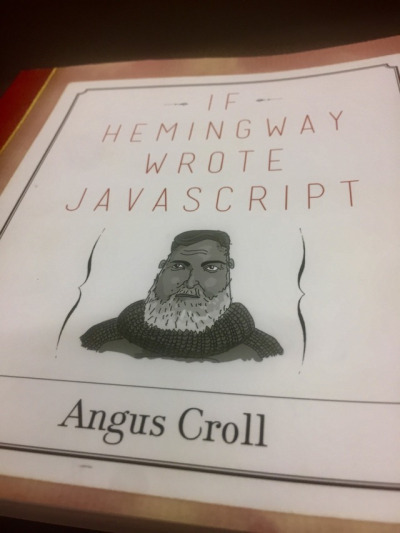
If Hemingway Wrote Code by Angus Croll reimagines the literary style if a range of writers into a short script of JavaScript code. The challenge in this text is to have each ‘writer’ to use JavaScript to solve several mathematical equations. And what we get is a pool of weirdness.
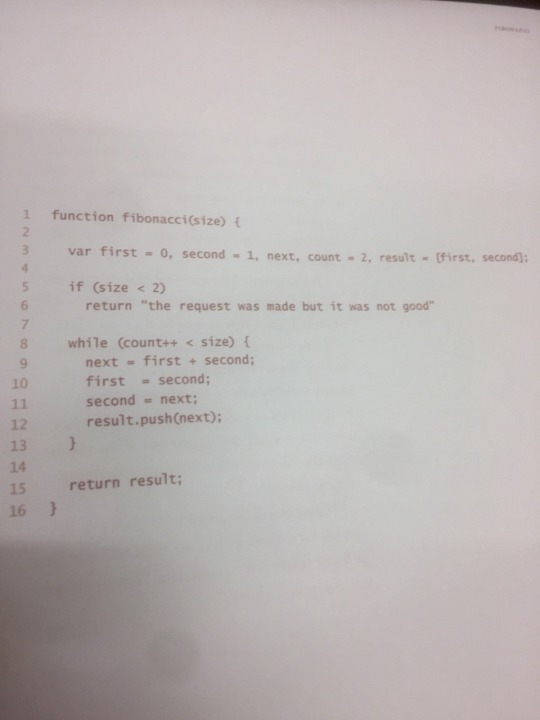
(Hemingway’s Fibonacci sequence)
The book itself is laid out very interestingly. With each different writer, Croll writes a brief intro on their individual writing styles, then lays out their attempt at writing this code, and then an analysis of how they wrote it.
It’s an incredibly interesting add on to the themes we’ve covered throughout this module and would have maybe been an interesting thing to look at when we were discussing intertextuality before the coding seminar.
“JavaScript has plenty in common with natural language. It is at its most expressive when combining simple idioms in original ways...And like natural language, it’s ready to write”
This brings me back to my previous blog post where I looked at the links between poetry and code as two very distinct, but shockingly similar forms of word and expression. This book does wonders to highlight this argument.
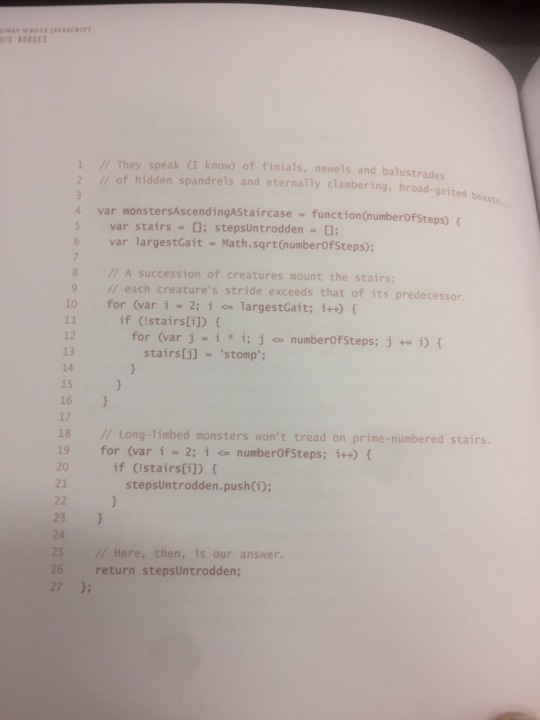
Take, for example, the above image. It is a script for writing prime numbers, written in the style of Borges (because we all love Borges). Croll notes how he combined Borges love of mathematical theory, the geometric arrangement of spaces, a suggestion of infinity, and a story within a story to create this set of code. Much like Borges style, this text is clean and well organised and free from unnecessary cleverness, however, maintains his well-known elements of mystery (with the ‘monstersAscendingAStaircase) and the mention of the over excited narrator.
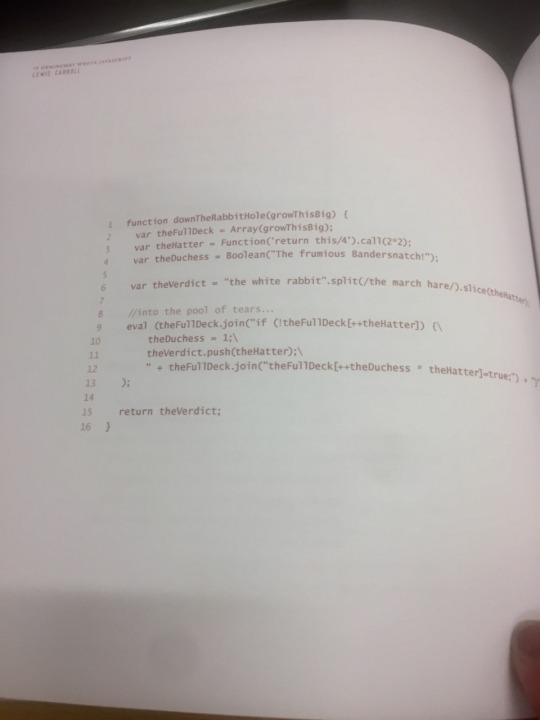
Likewise, here is the name prime number challenge, as though it were written by Lewis Carroll. Croll uses Carroll to highlight how unconventional and quirky JavaScript can be - much like the language Carroll used himself in the Alice in Wonderland novels. The re-working of functions to become different characters from Wonderland adds this extra layer of authenticity to his piece, going out of his way to make his JavaScript as oddball as possible.
“The future of JavaScript language depends on the willingness of its developers to push the limits.”
The notion of literary programming books is such a unique genre in itself, and by no means is it intended to be any form of instructional text, unless you really want to code like Tupac or Chaucer (although that might be cool), it’s purpose is to integrate coding language into the world of literature, and show how closely related the two spheres are.
Coding is not always good. But it’s always interesting. It took me about 2 hours to read this from cover to cover and I’m really sad it’s finished because now I want to see different authors, different coding formats, different problems. As a supplementary add on that is actually pretty related to the module, it’s great to see some of the themes we’ve looked at in class put into action.
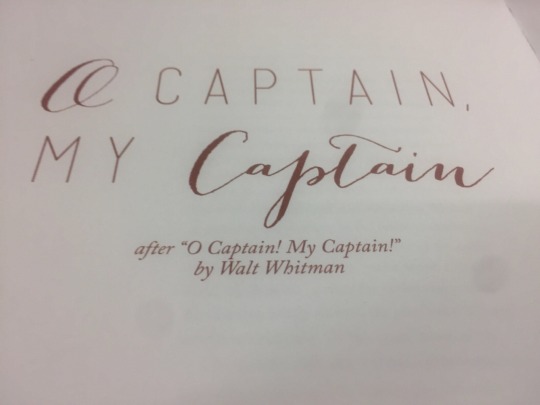
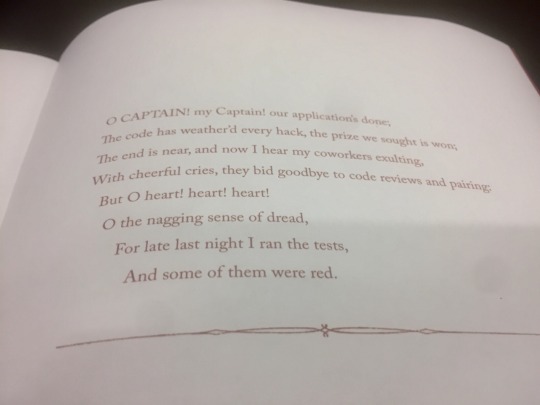
(I’m gonna miss these weird blog posts once this module is over)
#3178#digital textualities#if hemingway wrote javascript#angus croll#interactivity#coding#javascript
3 notes
·
View notes
Text
Simply Impassible; Nothing is Impossible
Ever think about weird and infinite the internet is? It’s like the digital version of the ocean - incredibly vast, largely undiscovered, and full of new and strange creatures. I’m also incredibly afraid of the ocean. The internet? not so much.
But the sheer quantity of things and stuff on the internet is absolutely insane! From cooking instructions to cat gifs, to information on how much your body parts would sell on the black market ($62,000 for a kidney in China...if only I had thought of that before taking out all these student loans). There’s really no shortage of content to peruse at your own idle leisure.
Which is something I wanted to tie into my project. In Alice’s Wonderland, it is easy to get lost, stuck, and trapped in the countless destinations of wonderland, and this is an element I wanted to highlight using the circular nature of my project. The ‘close browser’ button will always be there, similarly, there will always be a way out of Wonderland, no matter how long you spend there.
It reminds me of the Borges text The Garden of Forking Paths, which we discussed in class early on in the semester, looking at the metaphoricity of the book. The notion of a novel of infinite endings within Forking Paths distinctly parallels that of the internet. Isn’t the internet just another garden of forking paths and a book of infinite endings? Isn’t Wonderland literally a garden of forking paths - A place and a forest with infinite pathways and directions?
“This web of time – the strands of which approach one another, bifurcate, intersect or ignore each other through the centuries –embraces every possibility. We do not exist in most of them. In some you exist and not I, while in others I do, and you do not, and yet in others both of us exist.”
Jose Luis Borges ~ The Garden of Forking Paths.
Alice only went along a certain path through Wonderland; she only encountered what she came across on that one particular journey. The same can be applied to us when we traverse the internet. We only know what we’ve seen; the countless webpage’s we’ve wasted hours on are all we know of the online world. Because we haven’t explored the rest of it.
“I thought of a labyrinth of labyrinths, of one sinuous spreading labyrinth that would encompass the past and the future and in some way involve the stars.” Jose Luis Borges ~ The Garden of Forking Paths
The notion of Borges tale as a precursor to the internet and hypertext was also mentioned during both the lecture and the seminar but was completely above my level of intelligence to comprehend. And still is, to be honest; I guess as someone who was grown up with access to the internet since I was a small since, I’ve just taken for granted the fact that it has always been there, and never given much thought to anything otherwise. But it’s incredibly fascinating and brain hurting to think about.
On a side note, I found a post discussing an article Borges wrote about Lewis Carroll, where he described Wonderland as “that unstable world of figures that dissolve into one another where there is nightmare’s beginning”.
0 notes
Text
All Aboard the S.S. Theseus
So, a few weeks ago, I decided a good form of procrastination would be looking through the recommended reading for this module because at least that way it would feel more productive than sitting on Netflix watching the new Bill Nye show. And I know some of my classmates/banter squad had already looked at S: Ship of Theseus by J.J. Abrams and Doug Dorst, and it was conveniently payday, so I decided to buy it. And it was totally worth the £15 I spent on eBay. It reminds me of a book I had as a child, but for the life of me, I can’t remember what the book actually was. Only that it had letters tucked into pages, a pull out checkers board, maps, diagrams, and the sorts (note to self: find that book).


The book is designed to look like a library book, which has been essentially stolen from a high school library, and annotated (defaced, improved, whatever you’d rather describe it as) by two college students, who pass the book back and forward as they try and uncover certain elements of the book and the overall anonymity of its author. And I don’t think I’ve seen such a heavily annotated piece of fiction other than my A-Level copy of The Great Gatsby (I will add an image at some point because I have a silly amount of annotations in that book; still failed the paper the first time around though). The annotations take precedence over the fictional novel, which turns out to be much more interesting than the novel itself. They’re also laid out far better than those we’ve seen elsewhere on the module, such as in House of Leaves, where it was far easier to get lost and confused with the sheer quantity of footnotes and appendices. It took me the bulk of two months to read about 25% of HOL and I still have no heckin’ clue what is actually going on. S presents the conversation much more fluidly, with different handwriting styles and ink colors to highlight both the two different students and the different times they have had access to the book. Despite the seeming realism of the novel, however, it’s very obviously a printed fabrication of the story. The pen ink is obviously printed onto the paper with the text, there are no smudges or indentations that would indicate handwritten notes; the yellow legal paper feels more like printed paper than a notepad; essentially the book is in ‘too pristine’ a condition to feel just as authentic as it would have if it was a real book that two people had actually written in. And I mean, that’s fine, I have no qualms about that - because there’s no feasible way to handwrite a whole run of books like this and have them look exactly the same....imagine the time that would take. It’s still just as effective printed as it would be handwritten.



What’s best about this novel, aside from the annotations, are the inserts and extra pagings that litter the book. Now, I haven’t finished the book yet, in fact, I’m only about 100 pages in; but the first thing I did when it arrived in the post was to go through and look at each individual insert and the different postcards, letters, napkins, memos etc. They’re great in adding extra layers to the text, ironically increasing the authenticity of interactions between the two readers when the physical text itself is deeply covered in doubt and uncertainty (I actually really wish this book was real now because the whole mystery around it is fascinating. It reminds me of the fictional novel An Imperial Affliction in John Green’s The Fault in our Stars; I was almost more interested in book Agustus gives Hazel, than the book I was actually reading and I was so mad when I discovered it wasn’t a real thing).


The general idea of this book is actually fascinating and something I will definitely come back to once the oh so wonderful joys of deadlines are all finished #sarcasm. The concept is something so unique and so different from most traditional books I tend to read, yet there is a strong feeling of similarity within it. Like I said, I have books from school swarming in annotations and my own personal novels with different memos and arguments and comments along the margins - not to mention the beautiful people in the library who highlight and annotate critical books about the SAME TOPIC you’re writing about #lifesavers #realfriends.
2 notes
·
View notes
Text
Error 404: Poetry Not Found
Learning to code has been an interesting aspect I never thought I was going to have to do with an English degree. But it’s been hilarious, and frustrating and an incredibly interesting thing to discover.
My adventures in coding started very horribly when I was a young hip teenager wasting my days away on Tumblr (and sadly nothing has changed). Back in 2011 Tumblr blogs didn’t have anywhere near the amount of customising options that they did now - so if you wanted that pastel background, infinite scroll or a super edgy banner of My Chemical Romance (plot twist my blog was almost as emo as I was), you had to manually go in and edit all if that within the HTML. Back then I had no real clue what HTML, CSS, or Javascript even was, never mind how to write half of it. So countless days were spent trying to tweak lines and image sizes and colour numbers, and what made it worse was that it was all on the same damn page - so your CSS was mixed in with your HTML and it was a big mess.
(I was going to include a screenshot of an archived image of one of my old blogs but it was just too embarrassing.)
What has fascinated me over my stumblings on the internet, is how much code has been introduced into the poetic realm in recent years. I’ve found so many blogs and websites and books that detail poetry through several lines of code! And this so fascinating! I mean, there are undoubtedly a lot of similarities between the world of coding, and the world of poetry; both have their own series of strict, detailed rules, and in both cases, it is the level of skill and effort and time that dictates the good from the bad. In coding, where a long string of complex code might look impressive, it can sometimes contain too much irrelevance for a program to run. Whereas a minimalistic yet effective string of code can not only look much clean but performs the same command. Similarly, with poetry, you might write some complicated, metaphorical words that make you sound fancy, but it probably sounds like you were trying too hard, whereas something much simpler can have the same or more of an effect when read or spoken.
"Code poetry can mean a lot of different things depending on whom you ask. It can be a piece of text that can be read as code and run as program, but also read as poetry. It can mean a human language poetry that has mathematical elements and codes in it, or even code that aims for elegant expression within severe constraints” ~ Melissa Kagan.
Even a quick google can find an insane amount of poems made out of code, or literary competitions about code poems, or books of coding poetry, or books where a person has written code poems in the styles of famous writers.

It’s just interesting to think that this sort of poetic outlet was never considered before, yet as a thing, it makes perfect sense. Poetry and coding are so similar in so many ways that you begin to wonder why this wasn’t established sooner. Maybe poets were too pretentious about their metaphors and meters? Maybe computer engineers and software developers were too busy playing World of Warcraft and Runescape? Who knows!

But bringing the relevance back into this, this notion link in well to elements we’ve discussed throughout the module on the intertextuality between the written word and the modern era - it’s simply another form of expression combining two elements vital to everyday society; technology, and word. It goes to show that sometimes a Shakespearean sonnet isn’t the way to go, and maybe a jumble of parenthesis and semi-colons is the 'new thing'. (Side note: I wonder how such a thing has gone down with the elite traditionalists in the literary universe)
Images were found on this blog post.
I also found this interesting article on writing code as poetry (also the link to the above quote), which also has some other interesting links worth reading.
0 notes
Text
List of Lewis Carroll poems
The Jabberwocky
The Lobster Quadrille
All In The Golden Afternoon
How Doth The Little Crocodile
Twinkle, Twinkle, Little Bat
The Walrus And The Carpenter
You Are Old, Father William
This is just a list of poems I want to include in my final project - it is by no way a definite list, but essentially are the main poems in the Alice books that I like and would want to include in general
2 notes
·
View notes
Text
Down the rabbit hole, into the interwebs.
So, I guess it’s time to start looking at final projects and planning ideas and being productive with my time, as opposed to reading random posts on Stumbleupon and looking at aesthetically pleasing books on Tumblr.
I want to make use of the coding class we had a few weeks ago because it was actually incredibly interesting and will probably be far more helpful to my project that making something physical. I love the rules and structures of code; having something that follows a structure and system suits my brain better than a more creative design process.
To sum up my idea: I want to create an online, interactive storybook style narrative on the poetry of Lewis Carroll. I want it to be weird, and nonsensical and full of strange words and characters. And that’s all I currently have at this point. The rest of the idea is mostly trying to figure out layouts and platforms and strange pieces of coding.
I’ve been really obsessed with reading up on The Alice App (I don’t think it’s available on the UK iTunes store so I haven’t been able to download it so I’ve been reading reviews and watching YouTube walkthroughs instead). It’s a read through of the Alice in Wonderland story with a “Renaissance twist” that has just a beautiful design interface and constant interactive scenes - tilt your phone to make Alice fall down the rabbit hole or push the Mad Hatters teacups across the table. The app takes you through the entire story with the text on one page and these incredible interactive features on the others.
https://youtu.be/85Zsv0y-8WM
It’s interactive things like this that make we wish this kind of advanced technology was around when I was young. It’s just so much more engaging and immersive than a book. As a child I always found it difficult to engage in reading, despite reading a lot of books; but I came from a very tech-savvy family so I had access to a computer from a very young age, and my parents used to buy me and my sister a lot of interactive CD-ROM game story things. My favorite being one of Peter Rabbit where you clicked around various garden scenes and different items took you to different moments and tales from the Beatrix Potter collection.
And that always made stories more interesting for me; being able to see and visualize locations and characters, rather than having to picture them in my own memory made the stories just seem that bit more entertaining. So that is something I would like to concorporate into my final piece - something that could take you through elements of a story or in this case different poems. Incorporating the use of images, sounds, gifs (if I can figure out how to incorporate them) etc. would be great for increasing the interactivity throughout the wonderland of made up words and stories.
0 notes
Text
Reading Paintings
Can we read books as works of art? That comes with a reversal of can we look at art in book form, which is a silly question because of course, we can. Do you think I have the money to fly to NYC to see Turnbull's painting of Alexander Hamilton? Of course not! But, that doesn’t mean I can’t see it at all. That’s what biographies and art catalogs and the internet is for. I low key love those books you get in art museums that contain collections of the paintings they exhibit; it means I can bookmark paintings I like (and draw hearts on sticky notes for my all time faves aka anything by Turner), and come back to different pieces I want to reference or talk about.
The biggest difference between the two is time. Books take time to read and digest. Paintings take time too I suppose, but I can walk around an art gallery in a few hours (or 6 which was the ridiculous amount of time I spent in the Louvre last October), and still manage to look at and appreciate every painting. Imagine trying to read War and Peace in less than 6 hours – I’m sure someone probably had done it but they also probably hate their life. You cannot read a book in the same amount of time that you examine a painting. That’s not the point of books; they’re meant to be taken at a certain pace for a certain amount of time to allow us to understand and digest the words.
If we were to look at something like Nox, with the inclusion of images, photographs, graphite pencil marks, scribblings in ink, notes, memos, the works; and we were to look at how they all come together to present the narrative at hand, surely we could consider this to be art to some degree? I mean, it has the artistic layout of a scrapbook or journal, but the additional of these secondary pieces makes it into something more than just text to read. Not only do we have to perform the tasks of a literary critic on the actual words being said, but also an art critic, interpreting the meanings and reasons behind every image and drawing we come into contact with.
I recently came into contact with the work of Robert The, who collects old, discarded books and turns them into various pieces of art based on the themes and covers and irrelevance of said books. He’s said himself that the tossed books he collects for his projects “are lovingly vandalized back to life so they can assert themselves against the culture which turned them into debris.” Whether it’s carving a copy of Catcher in the Rye or The Bible into the shape of a gun and grenade, or binding pages into a noose, what The does is repurpose the notion of the book into something that can be read visually rather than literally.
0 notes
Video
vimeo
Probably doesn’t count as a blog post, but I found this video on an essay read by Stephen Fry and both the words themselves and the style of the video are incredibly interesting and worth a watch/listen
1 note
·
View note
Text
Twitter Poems
There is a website called poetweet, where you upload your Twitter handle, and it creates poems of various styles of poems out of various tweets. I’ve seen a few friends read them at different poetry shindigs, and they’re just a fun and entertaining way of creating poems and show how poetry is now evolving into the digital age.
So here are a few terrible sonnets courtesy of my Twitter.




There seems to be a running theme of trashiness here.
I also found this lovely Twitter bot tweeting out micro poetry from some sort of word generator.
It’s just interesting to see how poetry have evolved in order to keep up with new technologies, and how websites like poetweet could possibly encourage people to look at poetry a bit closer or as a tool to help gain interest.
0 notes
Text
Always Judge A Book By Its Cover
Do we judge books by their covers? Of course, we do. And don’t even try to say you don’t, because we know you’re lying. Keep that idiom away from books and back to the notion of judging people where it belongs.
Covers are the selling point for books. Realistically, a book isn’t going to sell if its front cover isn’t visually appealing. It’s a fact of life in our thriving capitalist society – making money and looking good go hand in hand. That’s not to say that a plain, basic cover doesn’t mean something isn’t a good read; if the lack of aesthetic is the aesthetic then sometimes that can be more effective overall. But publishers and authors want something eye catching; they want you to stroll through Easons or Waterstones and see a book and think “oh here that looks good, wonder what it’s about”. I have bought countless books on the basis of pretty and appealing covers, only to find out that the novel itself is utter rubbish and I never make it past the first few chapters – hence the piles of 70 odd books in my bedroom that are making their way to the charity shop in the future. It’s a wonderful ploy of trickery and enticement and I applaud them for it.
However, a huge problem with this is that nowadays, so many books look the same. Walk into the Young Adult fiction section and you’ll find dozens of black covers with faded wilting flowers (they did that with Wuthering Heights when Twilight was in its hay day because it was Bella’s favourite book and it was disgusting), birds, gothic symbols that represent themes in the novel, or pale skinned girls with long black hair and Victorian styled dresses, or dark dramatic portrayals of the forbidden romantic couple.
Same could be said with crime fiction, wit its plethora of maps, blood stains, and murder weapons. Vintage crime fiction, however, gets a pass in my books because their aesthetic is that bit nicer in my opinion. Romance novels too can have absolutely terribly identical covers and stylings, especially those low budget or independent books you can get cheaply, or on Amazon for free; you know the ones with the awful photoshop and stock images that make you want to both cringe and cry at the same time.
BUT, we’ve become so accustomed to seeing the same styles and associating certain cover images with certain genres that when we are fronted with something different, we have one of two thoughts; either “Oh that looks unusual that might be good”, or “eh, I dont know...”
That’s not to say that we should avoid buying books that look different or more individualistic. I’d advocate the opposite. Buy weird books. Books with funny covers. Books with no covers. Books with covers that don’t match the type of book you usually read. Because who the heck knows what kind of story it will be.
And if you’re bored. I found a funny website that pretty much asks you to judge a series of books by their covers. http://playjudgey.com/
https://www.thebookdesigner.com/2013/01/nick-thacker/
http://www.scribophile.com/blog/should-you-judge-a-book-by-its-cover/
http://beautifulbookcoversdotcom.tumblr.com/
http://lousybookcovers.tumblr.com/ (I really hope all of these are fake)
0 notes
Text
Anthropodermic Bibliopegy (the name of my new metal band)

During Monday’s Week 6 lecture on ‘The Magic Book’ we touched briefly on the notion of grimoires and other books being bound in human skin, which I found absolutely fascinating and so strange and weird that I started reading up on it as soon as I got home from class; which led me onto looking at serial killers, and people who made things like lamps and seat covers etc. out of human skins. (NEVER sit at home at night and watch a documentary on Ed Gein, unless you hate your life.) I swear I’m not weird.
But the entire concept of binding something in human skin is just so strange and unusual it made me wonder why people actually did it, and what different books looked like etc. So here is a small collection of different books bound in human skin and as much info as I could find on them.
As an Intro, I’d like to mention this website https://anthropodermicbooks.org who actively research anthropodermic books, testing them in order to prove that they are actually bound in human skin. They have identified a total of 47 books claimed to be bound this way thus far, and out of the 30 they have tested, 18 were confirmed to be books bound with human skin, the other 12 being bound in animal. They are an incredibly interesting site to read and I’d totally recommend giving it a look over.

The first is an example given to us during the lecture, which was basically my starting point for looking at these kinds of books. The faded gold on the black cover reads ‘Executed 28 Jan 1829’ and on the other side says ‘Burke’s Skin Pocket Book’. The history behind this book is as following; William Burke was a mass murder of the late 1820s, killing his victims and selling their bodies to Dr Robert Knox for dissection during his classes. Burke was found guilty of the murders and faced execution (and ironically dissection); his skeleton still remains in the Edinburgh Medical School, and his death mask and the mentioned book can be found in Sturgeons Medical Museum.

In Exeter there is a copy of The Poetical Works of John Milton kept in a museum, the cover of which is bound in the skin of George Cudmore; a man hung in 1830 and who’s sentence included dissection and the stripping of skin from his body. In 2011 the book made its first public appearance in an exhibition in Exeter.
Can you see a running theme here? Well not ever book bound in human skin were from executed bodies, although it need seem to be a popular form of punishment at the time. But hey! They were already dead, so I’m sure they won’t mind.


Another example can be found in the College of Royal Physicians in Philadelphia, where 3 out of the 5 anthropodermic books they own are bound in skin of an Irish Widow named Mary Lynch, who died aged 28 in 1869. Little is known about Lynch, other than she was in hospital due to TB and presumably died due to this, but we do know that a Dr John Stockton Hough performed her autopsy and wrote an incredibly detailed record of it. Before being buried in a paupers grave within the hospital grounds, Hough removed a portion of the skin on her thighs, but it wasn’t for another 20 years that her skin was used to bind three different books, one of which was Speculations on the Mode and Appearances of Impregnation in the Human Female. All three books bound in Lynch’s skin were non-fictional and on the topics of women’s health, virginity, and conception – so if that doesn’t sound like a weird fetish then I don’t know what does.
The practise of binding texts in human skin mainly took place during the early nineteenth century, but really took off during the American and French revolutions, basically because there were a plethora of bodies basically everywhere, which is fair. But there are also several books from before this time claiming to be bound in human skin.

(Im not sure if is the right image for the book but google said it was so heyo)
In a library at Brown University, there is a copy of De humani corporis fabrica libri septem by Andreas Vesalius dating from 1586. Vesailus produced a total of 7 books detailing the anatomy of the human body, each bound in a different material, this one, in particular, being human skin. It was bound a few centuries later, in the 1860s by J. Schavye of Brussels for the second World’s Fair in Paris. And whilst the book wasn’t originally bound in human skin, it’s just an interesting example of how a lot of anthropodermic books were often medical texts or something with a medical reason.

(idk if these are actually the skin books but they are the1755 Dictionaries so they’re just here as an example)
A contrast to this, however, would be copies of Samuel Johnsons 1755 Dictionaries, two of which were bound in 1818 using the skin of execution criminal James Johnson, who was hung on Norwich. I’d like to hope the surnames were coincidences.
The notion of anthropodermic books, and the general theme of using human skin to cover objects are such a strange concept, yet the macabre notion seems to skill travel over time and through other mediums. It seems to be a niche area in the horror genre, notably in the second (and freakiest) season of American Horror Story (that shit gave me nightmares for weeks I can’t look at Zachary Quinto the same anymore). I just can’t imagine how weird it would be to hold and read a book knowing that the back your holding was once part of a person. Freaky.
0 notes
Photo



My updated collection of journal-type books as of December 2015.
5K notes
·
View notes


